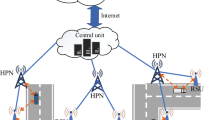Abstract
With the development of the wireless internet, there are more and more mobile terminals. Without mobility management protocol, mobile terminals could not communicate with others terminals when they are away from their home network. Mobile IPv6 was proposed which is host-based mobility management protocol. But it has several drawbacks, such as wireless link resource waste, load or consumption of power in mobile terminal is large. To overcome the weakness of host-based mobility management protocol, network-based mobility management protocol called Proxy Mobile IPv6 (PMIPv6) is standardized by the internet engineering task force network-based localized mobility management working group, and it is starting to attract considerable attentions. Although several proposals have been made for handover and Route Optimization (RO) in PMIPv6, they still need too many communications, do not consider about seamless-handover and RO without out-of-sequence problem simultaneously. In this paper we proposed a time-efficient handover mechanism in PMIPv6 by using the improved RO. We use the characteristic of anycast to achieve the time efficiency. By the mathematical analysis we prove that the proposed protocol has shorter latency and supports faster mobility of the mobile terminals.













Similar content being viewed by others
References
Lee, J. H., Lim, H. J., & Chung, T. M. (2009). A competent global mobility support scheme in NETLMM. AEU-International Journal of Electronics and Communications, 63(11), 950–967.
Johnson, D., Perkins, C., & Arkko, J. (June 2004). Rfc 3775: Mobility support in IPv6. IETF.
Perkins, C. E. (1997). Mobile IP, communications magazine. IEEE, 35(5), 84–99.
Shih, C. H., Kuo, J. L., Huang, C. H., & Chen, Y. C. (2011). A proxy-based fast handover scheme for hierarchical mobile IPv6. In Proceedings of the 5th international conference on ubiquitous information management and communication (p. 21). ACM.
Gundavelli, S., Leung, K., Devarapalli, V., Chowdhury, K., & Patil, B. (August 2008). Proxy Mobile IPv6. Tech. Rep., RFC 5213.
Kong, K. S., Lee, W., Han, Y. H., Shin, M. K., & You, H. R. (2008). Mobility management for all-IP mobile networks: Mobile IPv6 vs. Proxy Mobile IPv6. IEEE Wireless Communications, 15(2), 36–45.
Shbat, M. S., & Tuzlukov, V. (2012). Dynamic frequency reuse factor choosing method for self organizing LTE networks. Journal of Convergence, 2(2), 13–18.
Wang, L., Guo, H., Duan, B., & Liu, C. (2010). Route optimum mechanisms for local communication on PMIPv6. In Proceedings of the 2nd international Asia conference on Informatics in control, automation and robotics-volume 3 (pp. 80–83). IEEE Press.
Liebsch, M., Jeong, S., & Wu, W. (2011). Proxy Mobile IPv6 (PMIPv6) localized routing problem statement.
Choi, H. Y., Kim, K. R., Lee, H. B., Min, S. G., & Han, Y. H. (2011). Smart buffering for seamless handover in Proxy Mobile IPv6. Wireless Communications and Mobile Computing, 11(4), 491–499.
Zhou, X., Ge, Y., Chen, X., Jing, Y., & Sun, W. (2012). A distributed cache based reliable service execution and recovery approach in MANETs. Journal of Convergence, 3(1), 5–12.
Jeon, S., & Kim, Y. (2011). Adaptive handoff management in the Proxy Mobile IPv6 domain. In Vehicular Technology Conference (VTC Spring) (pp. 1–5). IEEE 73rd. IEEE.
Wang, X. (2008). A communication model on solving anycast scalability in IPv6. In Wireless communications, networking and mobile computing, 2008. WiCOM’08. 4th International Conference on IEEE (pp. 1–4).
Xie, Z., Wang, J., Wang, M., Chen, S. (2003). An improved anycast routing protocol in mobile ipv6. In Communications, computers and signal processing. PACRIM. 2003 IEEE Pacific rim conference on IEEE, vol. 2. (pp. 980–983).
Weber, S., & Cheng, L. (2004). A survey of anycast in ipv6 networks. IEEE Communications Magazine, 42(1), 127–132.
Hiyama, M., Kulla, E., Oda, T., Ikeda, M., & Barolli, L. (2011). Application of a MANET testbed for horizontal and vertical scenarios: Performance evaluation using delay and jitter metrics. Human-centric Computing and Information Sciences. doi:10.1186/2192-1962-1-3.
Hinden, R. M., & Deering, S. E. (2006). IP version 6 addressing architecture.
Teraoka, T. (2012). Organization and exploration of heterogeneous personal data collected in daily life. Human-centric Computing and Information Sciences. doi:10.1186/2192-1962-2-1.
Acknowledgments
This research was supported by Basic Science Research Program through the National Research Foundation of Korea (NRF) funded by the Ministry of Education, Science and Technology (2012R1A1B3004161).
Author information
Authors and Affiliations
Corresponding author
Rights and permissions
About this article
Cite this article
Jin, D.X., Shi, F., Chin, J.S. et al. Time-Efficient Handover Using Enhanced Route Optimization in Global PMIPv6. Wireless Pers Commun 73, 1369–1386 (2013). https://doi.org/10.1007/s11277-013-1255-0
Published:
Issue Date:
DOI: https://doi.org/10.1007/s11277-013-1255-0




